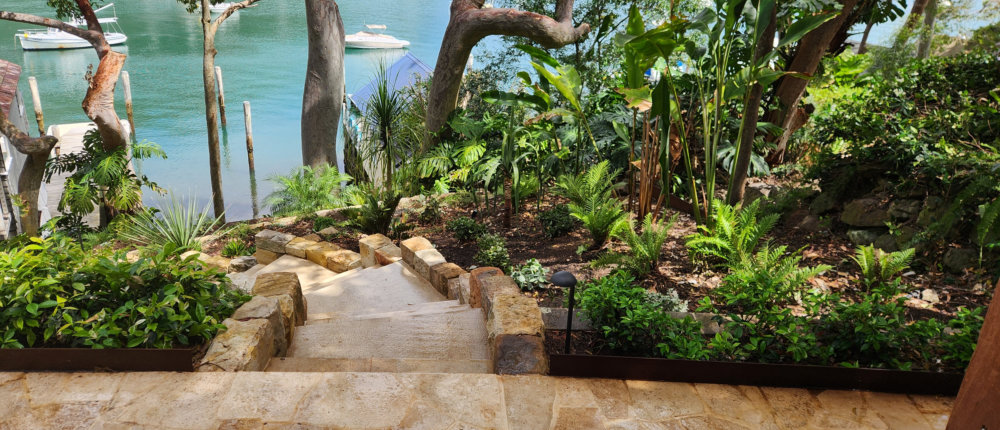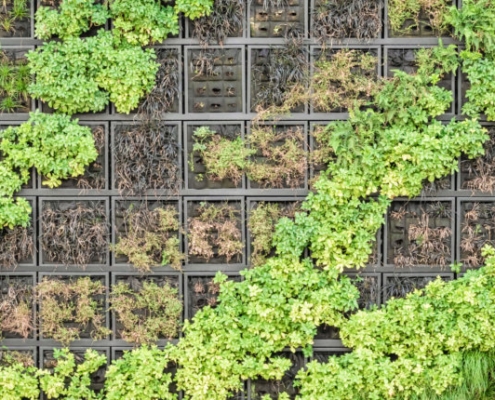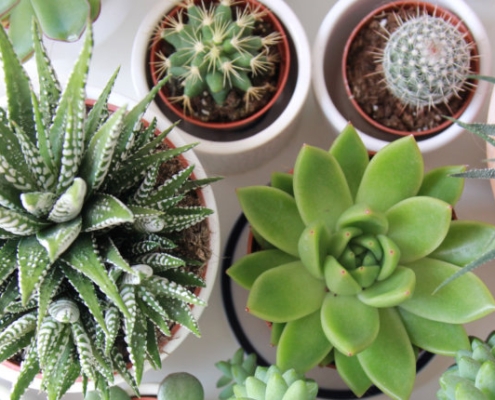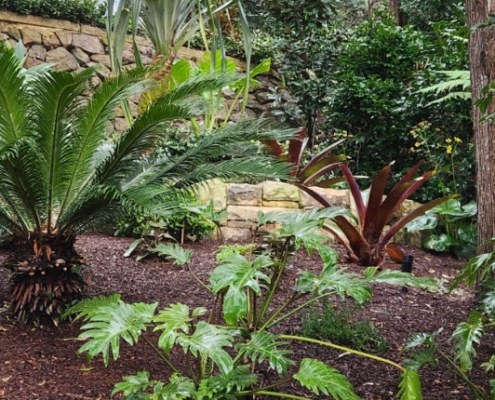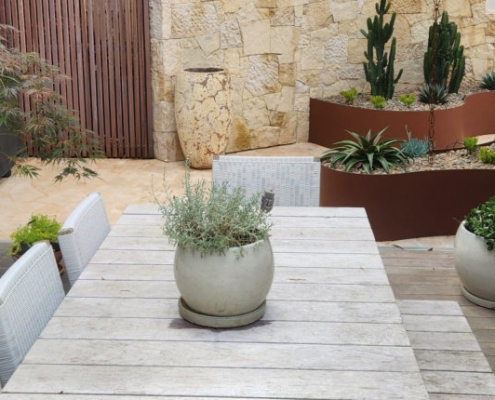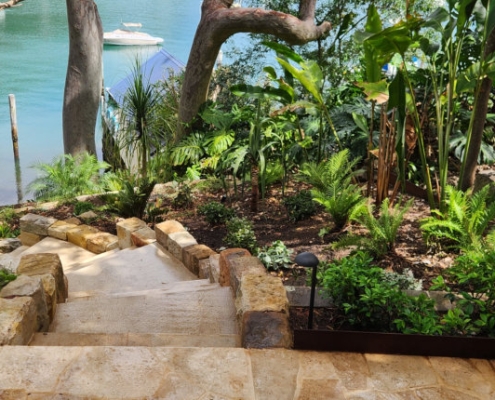Creating Balance in Garden Design: A Harmony of Elements
In the world of garden design, finding the right balance is crucial for a garden to look good and work well. This article dives into why balance is so important and how it affects the way your garden functions.
Think of a garden like a puzzle – there are lots of pieces, like plants, pathways, and lights. Getting the balance right is like fitting those puzzle pieces together in a way that makes sense and looks good.
We’ll be looking at how to balance different elements in your garden – things like plants, hard surfaces, water features, and lighting. It’s not just about making your garden pretty; it’s also about making it a healthy and happy place for plants and people.
Let’s explore the principles behind creating a balanced garden. From choosing the right plants to where you put your benches, we’ll break down the important decisions that go into making a garden that not only looks great but also works well. Let’s get started on the journey to a well-balanced garden!
Understanding Garden Elements
A. Plants
1. Variety and Selection
Selecting a diverse range of plants is a fundamental step in creating a garden that captivates the eye and stimulates the senses. Think of it as curating a palette of colours on a canvas; each plant is a unique brushstroke contributing to the overall composition.
Diversity Matters
A mix of plants introduces a rich tapestry of colours, textures, and forms. Consider combining flowering plants with evergreens, grasses, and shrubs to ensure year-round visual interest. This diversity not only enhances the aesthetic appeal but also promotes a healthier ecosystem within the garden.
Shapes and Sizes
The interplay of different shapes and sizes adds a layer of complexity and dynamism to the landscape. Taller plants can create vertical interest, while ground covers and low-growing varieties offer a pleasing contrast. Strategic placement based on the plant’s mature size prevents overcrowding and ensures a harmonious arrangement.
Layering for Depth
Layering plants at various heights contributes to a sense of depth and dimension. Tall plants at the back, mid-sized in the middle, and low-growing ones at the front create a visually balanced and well-organized scene. This layering technique allows each plant to shine while contributing to the overall harmony.
Seasonal Interest
Consider the seasonal characteristics of plants to ensure visual interest throughout the year. Choose a mix of deciduous and evergreen plants, incorporating those with distinct foliage colours and textures. This approach guarantees a garden that evolves with the changing seasons, offering a dynamic and ever-changing landscape.
Biodiversity and Sustainability
Beyond aesthetics, a diverse plant selection promotes biodiversity and sustainability. Different plants attract a variety of beneficial insects and pollinators, contributing to a healthier and more resilient garden ecosystem. Additionally, a diverse plant palette can make the garden more resistant to pests and diseases.
2. Colour and Texture
The hues and textures of plants play a pivotal role in creating visual interest. Careful consideration of colour schemes and textural contrasts adds depth and vibrancy.
Colour Harmony
Choosing the right colour palette is akin to composing a symphony of hues. Harmonizing colours creates a sense of unity and coherence throughout the garden. Consider the colour wheel to guide your choices—complementary colours create dynamic contrasts, while analogous colours provide a more serene and cohesive look. The strategic placement of bold and subtle colours contributes to the overall balance and visual interest.
Seasonal Transitions
Exploit the changing seasons by selecting plants with varying bloom times and foliage colours. This not only ensures year-round visual interest but also adds a dynamic element to the garden. From the vibrant blossoms of spring to the warm hues of autumn, each season brings forth a new color palette, contributing to the ever-evolving beauty of the landscape.
Texture as a Tactile Element
Texture introduces a tactile dimension, inviting touch and creating visual interest beyond colour alone. Incorporate a mix of coarse and fine-textured plants to provide contrast and depth. Plants with varied leaf shapes, such as the softness of ferns against the boldness of succulents, create a captivating interplay of textures. This adds depth and complexity to the visual composition, enhancing the overall appeal of the garden.
Foliage and Bloom Interaction
Diversify the garden’s visual experience by considering both foliage and bloom characteristics. Striking a balance between plants with showy flowers and those with interesting foliage ensures year-round appeal. Additionally, foliage colour can serve as a backdrop that enhances the brilliance of blooming flowers, creating a layered and visually compelling scene.
Contrast and Focal Points
Bold contrasts in colour and texture draw the eye and create focal points within the garden. Utilize plants with contrasting features strategically, such as pairing bold, textured foliage with delicate blooms. This not only guides the viewer’s gaze but also contributes to the overall balance and rhythm of the garden.
3. Height and Form
n garden design, the dimensions of height and form play a critical role in creating a visually balanced and well-structured landscape.
Tall plants, strategically positioned to the rear or against structures, provide a vertical element that adds spatial depth and drama to the garden. This arrangement enhances the overall aesthetic and influences the perceived size of the garden.
Mid-sized plants act as mediators, connecting the vertical and horizontal layers and ensuring a gradual descent in the garden layout.
Meanwhile, low-growing ground cover plants contribute to a cohesive ground cover, preventing soil erosion and maintaining visual continuity in designated areas, such as along pathways or under taller plants.
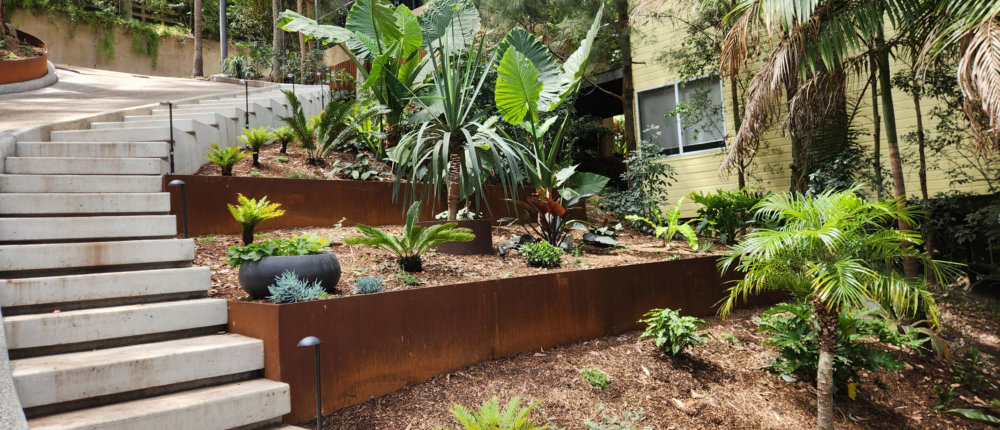
B. Hardscape
1. Paths and Walkways
Paths serve as essential connectors, guiding movement and defining the flow of the garden. Their design influences the overall layout, ensuring a harmonious connection between different garden zones.
Thoughtful consideration of materials, such as gravel, stone, or pavers, not only complements the overall design but also contributes to the tactile experience for those traversing the garden. The width and curvature of paths impact the sense of scale within the landscape, with wider paths providing a more open feel and narrower ones creating a more intimate atmosphere.
Beyond aesthetics, the practical aspect of paths and walkways is integral to the garden’s functionality. Well-placed paths facilitate easy access to different areas, making maintenance tasks more manageable and enhancing the overall usability of the outdoor space. Additionally, the strategic placement of paths can create focal points or guide attention toward specific garden features.
Lighting along paths further extends their functionality into the evening hours, ensuring both safety and a visually appealing nocturnal atmosphere. In essence, paths and walkways are foundational elements in garden design, seamlessly blending form and function to enhance the overall experience of the outdoor environment.
2. Structures
Garden design involves important elements like fences, pergolas, and other structures, which not only enhance the visual appeal but also serve functional purposes. Fences act as practical boundaries, outlining the garden’s perimeter and providing privacy and security. The choice of materials, whether wood, metal, or alternatives, significantly influences the garden’s overall aesthetic. Pergolas, with their vertical design, offer shelter and become dynamic focal points. Their lattice framework often supports climbing plants, introducing a vibrant, green element and seamlessly merging the built and natural environments.
The placement and design of outdoor furniture are equally crucial in defining the garden’s ambiance. From benches to tables and hammocks, furniture decisions impact the functionality and atmosphere of different garden areas. Well-arranged seating creates inviting spaces for relaxation or socializing, elevating the overall enjoyment of the outdoor space. Furthermore, these outdoor structures serve as focal points, grounding the landscaping and contributing to the garden’s coherence and balance.
3. Outdoor Furniture
Outdoor furniture plays a significant role in shaping the character of a garden, influencing both its functionality and ambiance. Choices ranging from benches and tables to loungers and hammocks contribute to the overall design and experience of different garden areas. Thoughtful placement of this furniture creates inviting spots for relaxation or socializing, enhancing the overall enjoyment of the outdoor space.
Beyond their practical utility, outdoor furniture pieces become integral elements of the garden’s aesthetic. The materials, styles, and colors chosen for these pieces contribute to the overall visual harmony. A well-curated selection of furniture not only provides comfort but also adds a touch of personality to the garden.
Whether creating a cozy corner for quiet contemplation or a sociable space for gatherings, the strategic incorporation of outdoor furniture enriches the garden’s atmosphere and functionality. In essence, these pieces serve as essential components in the garden’s design, ensuring a seamless integration of comfort and style within the outdoor environment.
C. Water Features
Water features constitute significant elements in garden design, contributing both aesthetic charm and functional dynamics to outdoor spaces. Ponds, fountains, and streams introduce a dynamic element that elevates the visual appeal of the garden. Beyond their ornamental value, these features can also serve as focal points, creating points of interest within the landscape.
The integration of water features is not merely for visual pleasure but also plays a role in establishing a balanced and harmonious environment. Properly placed, these features become more than decorative; they contribute to the overall ecosystem of the garden. For instance, ponds may attract beneficial wildlife, while the gentle sound of flowing water can create a serene and calming atmosphere.
Water features, when thoughtfully incorporated, add a layer of richness to the garden. They serve as more than decorative elements, becoming integral contributors to the overall aesthetic and ecological balance of the outdoor space. From fostering biodiversity to providing a tranquil soundscape, water features enhance the garden’s allure and contribute to its overall harmony.
D. Lighting
Outdoor lighting is not merely about visibility; it is a strategic tool that enhances safety, extends usability into the evening, and adds a captivating visual dimension to the garden.
Functional aspects of outdoor lighting include illuminating pathways, steps, and potential hazards, and ensuring safe navigation within the garden after dark. Moreover, well-placed lights can highlight key features, such as plants, sculptures, or architectural elements, creating focal points and extending the garden’s visual interest into the nighttime hours.
Aesthetic considerations involve the careful selection of lighting fixtures and their placement to achieve a desired ambience. Whether it’s soft, warm lighting for a seating area or more dramatic illumination for architectural features, the choice of lighting influences the garden’s overall mood. The strategic placement of lights also creates shadows and contrasts, adding depth and dimension to the landscape.
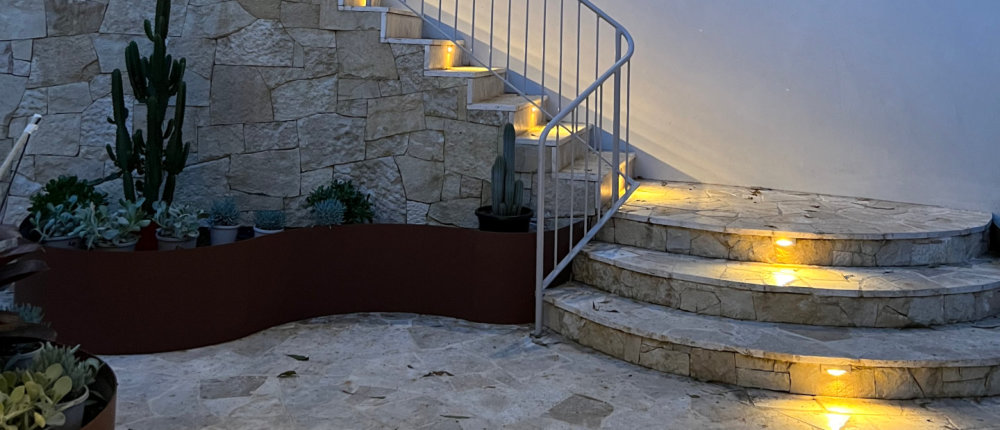
Principles of Balance in Garden Design
A. Symmetry vs. Asymmetry
The principles of balance in garden design revolve around finding a harmonious arrangement of elements. One key consideration is the balance between symmetry and asymmetry.
Symmetrical designs, where elements are mirrored on either side of a central axis, can create a sense of order and formality. On the other hand, asymmetrical designs introduce a dynamic and less predictable feel to the garden. Striking the right balance between these two approaches ensures visual interest while maintaining an overall sense of coherence.
B. Visual Weight
Understanding the concept of visual weight is crucial in achieving balance. Different elements in the garden carry varying degrees of visual weight, with larger, darker, or more intricate features holding more prominence. Balancing visual weight involves distributing these elements strategically to create equilibrium.
Focal points, such as a well-placed sculpture or a vibrant flower bed, can act as anchors, while lighter or less conspicuous elements provide a counterbalance. Achieving a balance in visual weight ensures that no single element dominates the garden, resulting in a well-rounded and visually pleasing composition.
C. Colour Balance
Colour plays a pivotal role in garden aesthetics, and achieving balance involves a thoughtful approach to colour selection and distribution. Complementary colours, those opposite each other on the colour wheel, create dynamic contrasts, while analogous colours, found next to each other, offer a more harmonious palette. Seasonal considerations also come into play, ensuring a balance of colour throughout the year. Striking the right colour balance prevents the garden from appearing overly busy or monotonous, contributing to a visually cohesive and balanced design.
Practical Tips for Achieving Balance
A. Planning and layout
Planning and layout are foundational aspects of successful garden design, playing a crucial role in achieving a harmonious and well-balanced outdoor space. Before diving into plant choices or decorative elements, taking the time to plan and design the garden layout is essential for creating a space that is both functional and aesthetically pleasing.
1. Assessing Site Conditions
Begin the planning process by thoroughly assessing the site conditions. Consider factors such as sunlight exposure, soil quality, and drainage patterns. Understanding these aspects helps determine the suitability of plants and structures, ensuring that they thrive in their designated locations. This initial assessment lays the groundwork for a garden that is not only visually appealing but also conducive to healthy plant growth.
2. Functional Zoning
Dividing the garden into functional zones is a practical approach to achieving balance. Identify areas for entertaining, relaxation, and gardening, and plan their layout accordingly. Creating distinct zones allows for better organization and ensures that each area serves its intended purpose. The layout should facilitate easy movement between zones while maintaining a cohesive overall design.
3. Consideration of Proportions
Maintaining a sense of proportion in the garden layout is crucial for achieving visual balance. Consider the mature size of plants and how they will fit into the space over time. Avoid overcrowding by allowing adequate spacing between plants and structures. Strive for a layout that complements the scale of the surrounding environment, creating a balanced composition that feels integrated and in harmony with its surroundings.
4. Flexibility for Growth
Plan with future growth in mind. Trees and shrubs, for example, may start small but can significantly alter the garden’s dynamics as they mature. Anticipating this growth allows for a more sustainable and enduring design. Incorporate flexibility in the layout to accommodate changes, whether in plant size, additional features, or evolving functional needs.
B. Maintenance and care
Maintenance and care are ongoing commitments integral to sustaining a well-balanced and thriving garden. Regular attention to various aspects ensures that the initial design vision is not only preserved but also evolves harmoniously over time.
1. Pruning and Trimming
Regular pruning and trimming are essential for maintaining the shape, size, and health of plants. This practice prevents overcrowding, encourages proper air circulation, and promotes the overall aesthetics of the garden. Tailoring the growth of plants through pruning also contributes to the balanced distribution of visual weight within the landscape.
2. Weeding and Soil Care
Weeding is a fundamental task to prevent the intrusion of unwanted plants that can disrupt the garden’s balance. Additionally, caring for the soil by providing necessary nutrients and addressing drainage issues is crucial for the health of plants. A well-nourished soil base contributes to the vitality and resilience of the garden.
3. Seasonal Adjustments
The changing seasons bring different needs for the garden. Adjustments, such as mulching to retain moisture in the summer or protecting delicate plants in the winter, help the garden adapt to seasonal variations. Seasonal maintenance ensures that the garden remains visually appealing and functional throughout the year.
4. Inspecting and Adapting
Regular inspections allow for the early detection of potential issues, whether it’s pests, diseases, or changes in plant health. Prompt intervention can prevent the spread of problems and maintain the overall balance of the garden. Additionally, being open to adaptation is crucial; the garden’s needs may change over time, and adjustments to the layout, plant selection, or functional aspects may be necessary.
5. Watering Routine
Establishing a consistent watering routine is vital for plant health. Different plants have varying water requirements, and understanding these needs prevents overwatering or underwatering. Proper hydration not only sustains plant life but also contributes to the garden’s visual vibrancy.
In the world of gardening, creating a balanced and beautiful space is like putting together a perfect puzzle. Every plant, structure, path, and light has its role, and when they all work together, they make a harmonious garden. It’s not just about making things look good; it’s also about taking care of the garden to keep it healthy and happy over time. So, whether you’re picking the right plants or deciding where to put a bench, remember that balance is the key to making your outdoor space not just pretty but a place that feels just right. May these ideas encourage all garden lovers to enjoy the journey of creating a garden that’s not just balanced but also a peaceful and thriving haven in nature.

